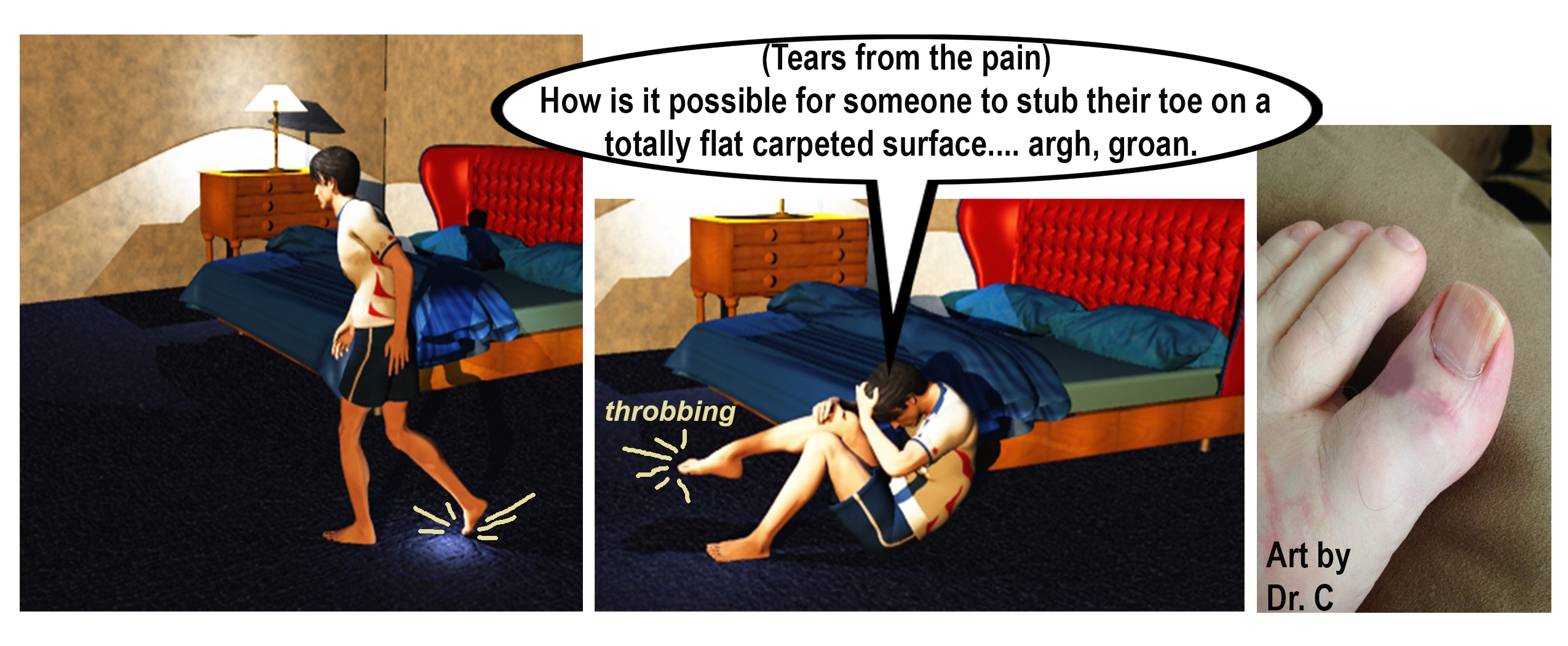Foot Problems as an Early Sign of PD: Oh, What a Drag It Is!

(Graphic by Dr. C)
Search on the internet for early signs of Parkinson’s disease. Surprisingly, you will not find foot drag on most of the lists. Yet, Ali Samil, in the chapter “Cardinal Features of Early Parkinson’s Disease,” in the book “Parkinson’s Disease: Diagnosis and Clinical Management,” lists foot drag as an important early symptom.
I have been dealing with foot drag for a few years — that squeak of the sneaker on the kitchen floor when the foot drag catches, scuff marks left behind. While at a professional conference, the foot drag caught the top edge of a stair just as I was headed down, and down I went, grasping the handrail to rescue an awful fall. Recently, it has been much worse, and oh, what a drag it is now.
Reflecting on it, it seems almost impossible that I could seriously hurt my foot walking on a flat, carpeted surface with no obstacles in the way. But that is exactly what happened. Walking barefoot on a carpeted floor, my foot dragged, and then my big toe jammed into the carpet — HARD! I screamed, tears flowed, and I fell to the floor weeping from the pain. The toe turned a nice purple shortly thereafter, but luckily nothing was broken. I don’t walk barefoot anywhere now, except for a few steps in and out of the shower.
I am surprised that there is not more mention of foot drag in the lists of early PD symptoms. If it is a cardinal early symptom, then both patients and care providers should be given the heads up (or maybe feet down), along with some guidelines on how to adjust.
If a patient does have this symptom, then perhaps it doesn’t show up all the time, but rather only during off periods and deep fatigue. If the patient has a favorite pair of shoes, then perhaps signs of the foot drag can be seen on the wear pattern in the shoes.
The indications of foot drag problems don’t have to be as dramatic as my story before they become something that needs attention. My attention is given to the footwear I purchase, limiting my walking during deep fatigue, and carefully watching my feet when changing surface levels (such as a curb on sidewalks).
Maybe there are readers out there who have dealt with foot drag and have a story to tell with suggestions about how to cope. Next time someone says to you, “Quit dragging your feet on this,” tell them about this column.
***
Note: Parkinson’s News Today is strictly a news and information website about the disease. It does not provide medical advice, diagnosis or treatment. This content is not intended to be a substitute for professional medical advice, diagnosis, or treatment. Always seek the advice of your physician or another qualified health provider with any questions you may have regarding a medical condition. Never disregard professional medical advice or delay in seeking it because of something you have read on this website. The opinions expressed in this column are not those of Parkinson’s News Today or its parent company, Bionews Services, and are intended to spark discussion about issues pertaining to Parkinson’s disease.







Daniel Wilkins
Dr. C., thank you for highlighting this feature. Foot-dragging was an early symptom for me, too. For several years before I developed a tremor and was diagnosed, I would often catch a foot on the carpets at the university building where I taught. Fortunately, my reactions were quick enough that I never fell down. There was no way I could connect this with any disease, let alone Parkinsons. I thought it was due to lack of alertness, fatigue, or laziness in lifting my feet when I walked. I was then in my early sixties and regarded it as just an ordinary byproduct of growing old.
Andrew
A couple of years before my diagnosis, I began having trouble with foot drag. This was compounded by the development of Morton's neuroma in my left foot (very painful). "Toe curl" muscle contraction is fairly common in Parkinson's, making it difficult and painful to walk. Add to that balance issues typical of PD and you have a recipe for significant mobility impairment, probably my biggest complaint. PD meds (Sinemet)have helped with foot drag, but I still have to limit the amount of time I spend on my feet to 5-10 minutes at a time. I am constantly looking for the perfect pair of shoes, currently Altra Torin (plenty of room for sore toes). Not perfect, but OK. I always have to be careful when walking.
Rose
I too have foot ankle and leg problems.
All of a sudden when walking my feet ankle wouldn't work refusing to bend, felt like cramping.
Had all the tests, told the early Parkinsons, but they are waiting till it develops to be curtain. I am now limited to short walks because of tingling pain from instep to knee, feels like an open wound, look down and nothing.
I am seeing a Professor Neurologist.
JW
Dr C., Thanks for sharing your story. I had the same experience with yours 4 years ago, and I was not able to connect it as a symptom of early PD until spring 2018 when another symptom, tremor was added to the same side of body on my hand. Thinking back, I was only 37 and it was a truly dark period of my life trying to avoid meeting and walking with people without knowing what happened to my feet. Now I am 41 with early and mild stage of PD taking Azilect and Sinemet whenever I need them to walk properly in important meetings/situations, but I am not quite sure if I am correctly treating myself in medication. I am worrying about the side effect of Sinemet, dyskinesia, and wanted to stay away from the PD meds as much as I can.
I am a big fan of your articles, by the way. I am trying to see the bright side of life as I read your articles with good energy to keep good life with PD.
Dr. C
Thanks for sharing JW, and the positive encouragement is greatly appreciated. There are days when it's tough for me to get both the column and the graphic art done in time. When I read that people enjoy, and benefit, from them - - well it's like putting a little more fuel in the gas tank.
Ann
I too am experiencing dragging my feet as if they weigh a ton and tripping over absolutely nothing...it is frustrating and daunting. I thought it was due to exhaustion until the other Symptoms came.
Dr. C
Hi Ann ~ Thanks for the comment. See my response to Mike who also identified that foot dragging and tripping are prevalent symptoms. I have to really pay attention to putting body in motion!
Appreciate you reading the columns and taking the time to comment.
Dr. C.
Mike
First real symptom for me. Have fallen a lot when toe catches something. I work on strengthening ankle toes feet. My legs feel like they run out of gas some days. Keep digging heals in when walking- don’t get too distracted.
Dr. C
Hi Mike ~ it was my first symptom also. Had major foot drag for several years, slowing of walking and shuffling, when I was 47 years old. No one mentioned Parkinson's at that point but the providers did recognize something "wasn't right". Took getting to age 64 before a neurologist recognized what it was. Now the balance issues have kicked in. And you hit the nail on the head... "don't get distracted". I think the adage "can't walk and chew gum" must have been made for us.
Keep positive, thanks for reading the columns and I appreciate hearing your perspective.
Dr. C.
Jean Thurber
Hi Dr C.
I am what my Neuro calls “Parkinson’s Watch.” I go back next week. All the blood work she ordered came back good. I don’t have Lyme, lupus, etc. The more I read, the more down I get. I just turned 60 and have during the past year have started falling. I’ve been tripping over my feet for a few years now. Falling going up the stairs. Trouble lifting my foot high enough to get dressed, to get into my car, etc. I just kept telling myself and others that I’m just a clumsy girl. I’ve had essential tremor for 20 years and just in the last year I’ve had resting tremor. My calves are in a constant state of spasm. I have no sense of smell left. Is there a benefit of getting a diagnosis. I’ve been dealing with the symptoms for so long.
Connie
Thirty-six yo family member was walking on the outer edges of his feet, and "holding on to walls" for balance before diagnosis and treatment started. How common are those symptoms?
Dr. C
Hi Connie ~ Sounds like a discussion for your family member to have with his/her neurologist. Since you say the diagnosis and treatment were given, it may be one of the signs of Parkinson's. Researchers have suggested that foot drag can be an early symptom. Given that we know that Parkinson's disease expresses itself in a wide diversity across the population, it would make sense that foot drag issues would also display a diversity of features. Saying anything more than that is outside my realm of professional expertise. A good neurologist or movement disorder specialist consult would be best. Thanks for reading the column and I appreciate your comment. Hope you continue to follow along in "Possibilities with Parkinson's" and the other features that the website offers.
Dr. C.